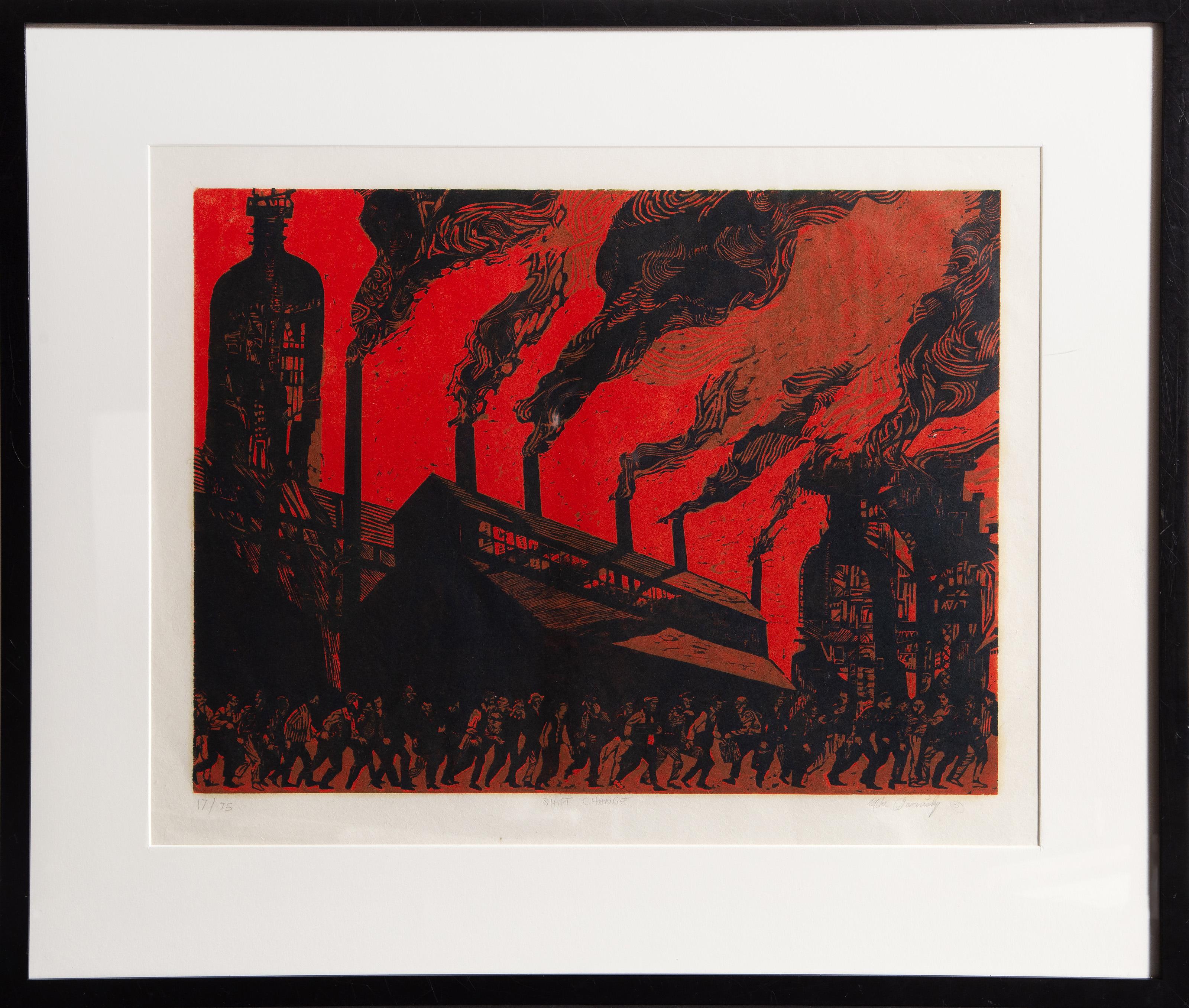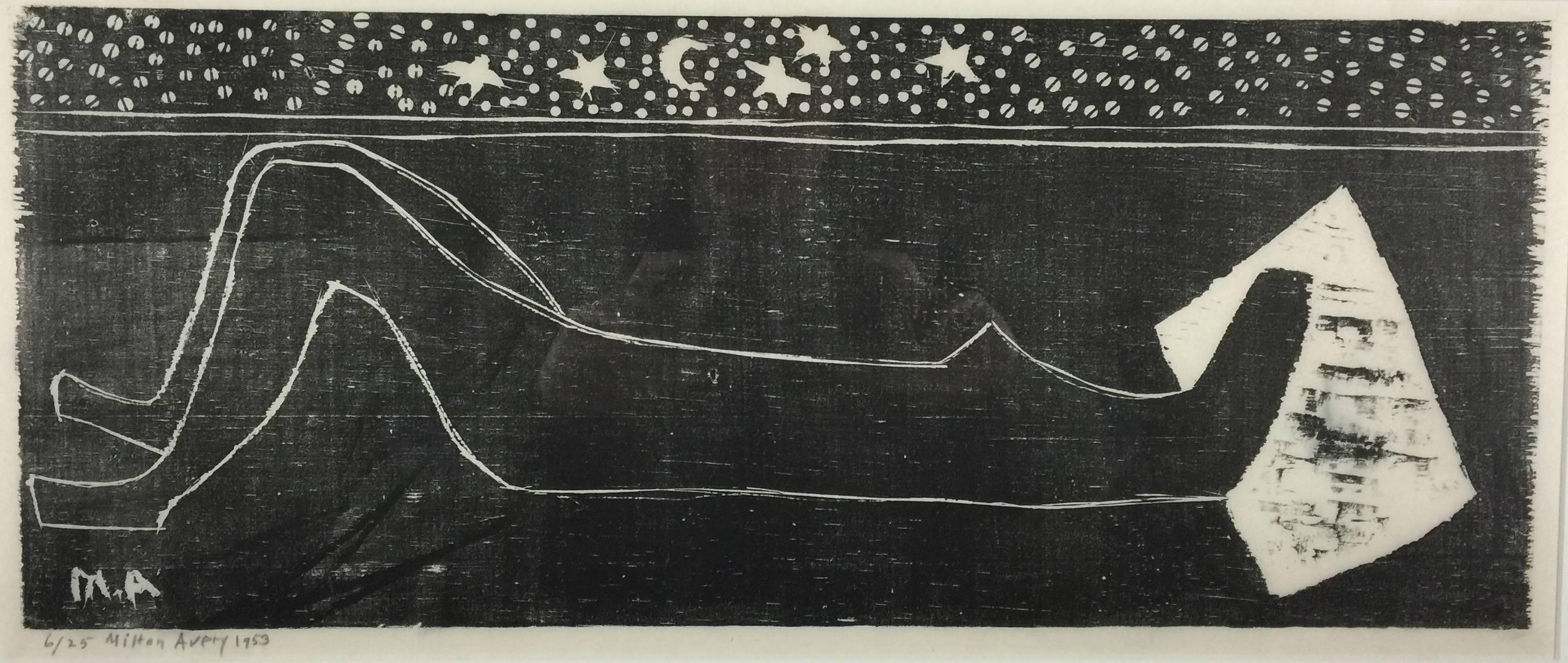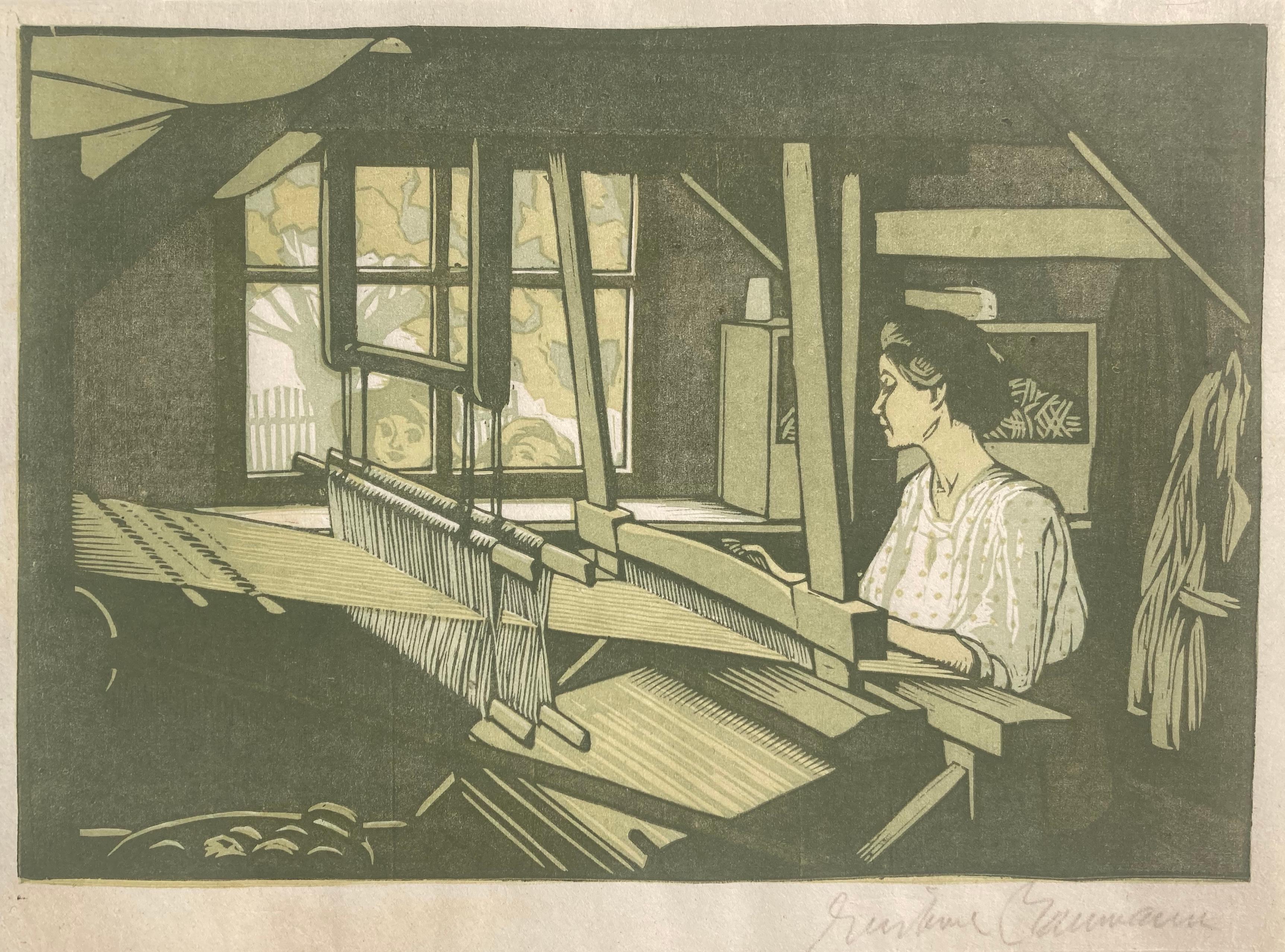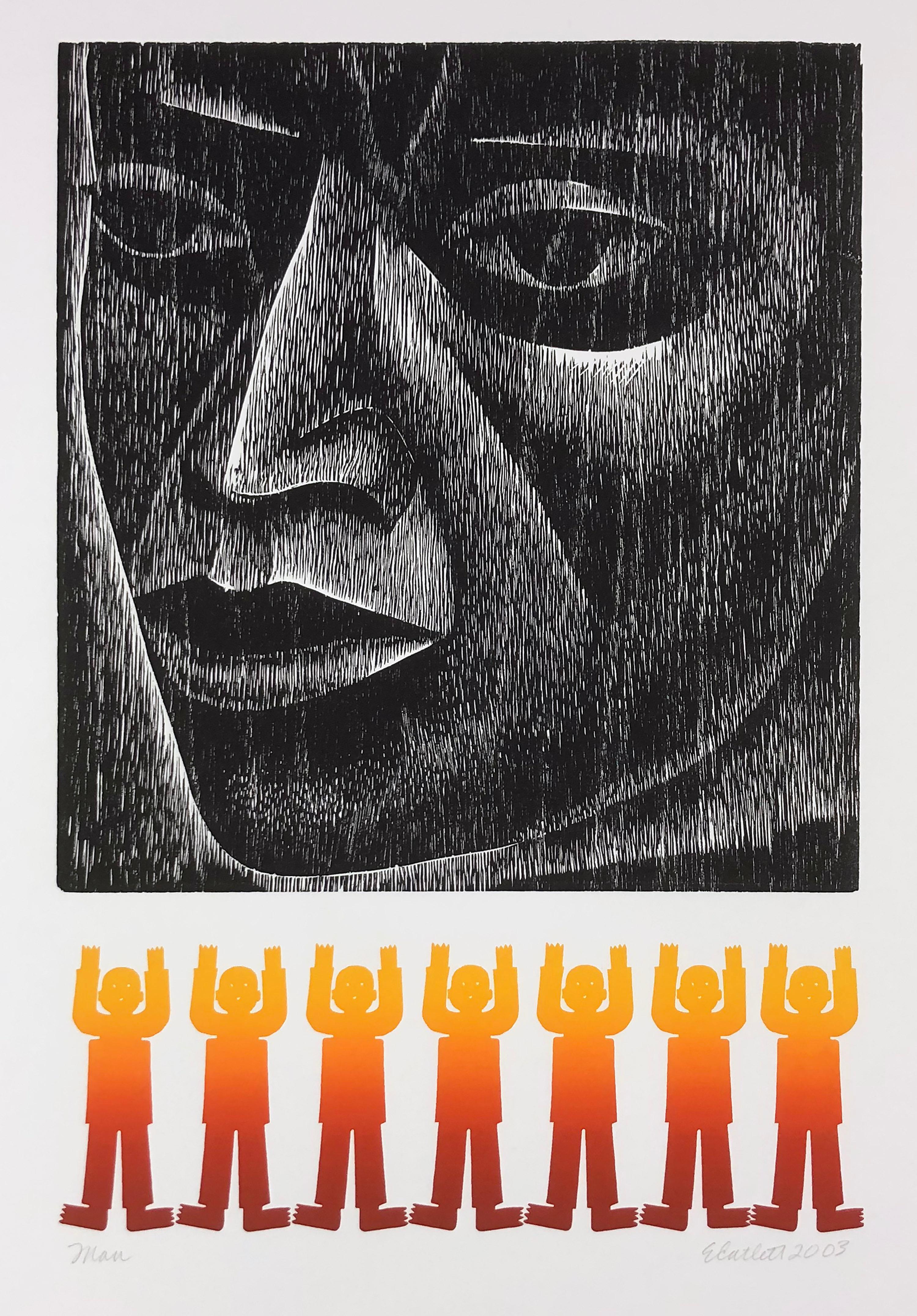Items Similar to "Merry Christmas, " Original Color Woodcut signed with stamp by Sylvia Spicuzza
Want more images or videos?
Request additional images or videos from the seller
1 of 5
Sylvia Spicuzza"Merry Christmas, " Original Color Woodcut signed with stamp by Sylvia Spicuzzac. 1950
c. 1950
About the Item
"Merry Christmas" is an original color woodcut on paper by Sylvia Spicuzza. The artist stamped her signature lower right. This artwork features the an abstracted figure on orange paper with yellow and blue accents.
5 1/2" x 4" art
11" x 9 1/2" frame
Born in 1908, Sylvia Spicuzza was the daughter of noted painter Francesco Spicuzza. Sylvia devoted herself to teaching art to the students of Lake Bluff Elementary School in Shorewood, WI. During this time Sylvia produced a magnificent body of work that was undiscovered until her death. Sylvia's work is rich, diverse and fascinating collection of drawings, watercolors and prints from the 1920's to the 1990's. Her style ranges from early figurative drawings to regionalism, art deco, lyrical abstractions of every conceivable subject (both real and imagined), as well as figurative paintings that reflect the work of Picasso and Ernest Max in the 1930's and 1940's. Biomorphic and organic, Modernist images are presented with Sylvia Spicuzza's own unique sense of style, humor and fantasy.
- Creator:Sylvia Spicuzza (American)
- Creation Year:c. 1950
- Dimensions:Height: 11 in (27.94 cm)Width: 9.5 in (24.13 cm)
- Medium:
- Movement & Style:
- Period:
- Condition:
- Gallery Location:Milwaukee, WI
- Reference Number:
About the Seller
4.9
Platinum Seller
These expertly vetted sellers are 1stDibs' most experienced sellers and are rated highest by our customers.
Established in 1966
1stDibs seller since 2017
Typical response time: 1 hour
- ShippingRetrieving quote...Ships From: Milwaukee, WI
- Return PolicyA return for this item may be initiated within 14 days of delivery.
More From This SellerView All
- "Angelika's Pets, " Wood Engraving by Robert Franz Von NeumannBy Robert Franz Von NeumannLocated in Milwaukee, WI"Angelika's Pets" is an original wood engraving by Robert Franz Von Neumann. It features a young woman sitting at a desk, working on a wood engraving. Two large cats sit near her and look out a window nearby. Image: 6" x 5" Framed: 13.43" x 12.43" 1888 - 1976 Born in Rostock, Mecklenburg, Germany, Robert von Neumann...Category
1930s American Modern Figurative Prints
MaterialsWoodcut
- "Underground, " Wood Engraving by Gerhardt H. BakkerLocated in Milwaukee, WI"Underground" is an original wood engraving by Gerhardt H. Bakker. It features a man working in an underground tunnel, chipping away while his shadow warps to the bend of the wall in front. Image: 6" x 6.5" Framed: 15.43" x 15.87" Known as a “Jack-of-all-Arts and Master of Many,” Gerhard Bakker’s work covered a broad range of media: watercolor painting, drawing, and graphic arts in lithography, etching and block printing. He was photographer, advertising designer, illustrator and prize winner in numerous exhibitions. Born to Dutch parents in Germany, he studied and taught at Gewerbeschule in Solingen. In 1930, at the age of 23, he moved to Milwaukee. He subsequently studied under Gerrit V. Sinclair at the Layton School of Art. As the Depression deepened in the United States, he joined the faculty of the Layton School of Art and started the Photography Department. Bakker also lived and shared studio space in the Plankinton Avenue Art Colony during these same years. Bakker was involved with the Public Works Arts Project in 1933-34. In 1934 he studied at the Broadmoor Art Academy in Colorado Springs under Boardman Robinson, Ward Lockwood and Tabor Utley...Category
1930s American Modern Figurative Prints
MaterialsWoodcut
- "Chamber Music" Interior Scene of Musicians Wood Engraving by Robert Von NeumannBy Robert Franz Von NeumannLocated in Milwaukee, WI"Chamber Music" is an original wood engraving by Robert Franz von Neumann. It features a room full of men in the thralls of creating music together. A small audience stands outside their circle. Image: 5.5" x 7" Framed: 14" x 15.56" 1888 - 1976 Born in Rostock, Mecklenburg, Germany, Robert von Neumann...Category
1930s American Modern Figurative Prints
MaterialsWoodcut
- 'The Rabbit' original woodcut engraving by Clarice George LoganBy Clarice George LoganLocated in Milwaukee, WIIn 'The Rabbit,' Wisconsin artist Clarice George Logan presents the viewer with a multi-figural scene: under a wood-frame structure, four children crouch on the ground, gathered around a young woman who presents a rabbit. Under normal circumstances, such an image of children with a bunny would recall childhood storybooks. In this case, however, the image is more ambiguous and suggests the unfortunate economic circumstances many children suffered during the interwar years. Nonetheless, the group could also be interpreted as a nativity play, with the rabbit taking the place of the Christ child, shining light on the children like in a painting by the Italian Renaissance artist Correggio. The careful line-work of the woodblock engraving adds a sense of expressionism to the scene, leaving the figures looking distraught and dirty, though the image nonetheless falls into the Social Realist category that dominated American artists during the Great Depression. This print was published in 1936 as part of the Wisconsin Artists' Calendar for the year 1937, which included 52 original, hand-made prints - one for each week of the year. Clarice George Logan was born in Mayville, New York in 1909 but moved to Wisconsin in 1921. She attended the Milwaukee State Teachers College from 1927 to 1931 where she studied with Robert von...Category
1930s American Modern Figurative Prints
MaterialsEngraving, Woodcut
- 'Jones Island' original woodcut engraving by Gerrit SinclairBy Gerrit SinclairLocated in Milwaukee, WIThe print 'Jones Island' is something of a self portrait. In the image, an artist stands before and easel, depicting the docks and buildings on the coast. The title indicates that this is Jones Island in Milwaukee, the peninsula along Lake Michigan that today is home to largely industrial buildings. The buildings and figures in the print suggest that this might be a view of the last of the Kashubian or German immigrant settlements on the peninsula before they were evicted in the 1940s to make way for the development of the harbor. The artist in the image thus acts as a documentarian of these peoples. The careful line-work of the woodblock engraving adds a sense of expressionism to the scene, leaving the figures and buildings looking distraught and dirty, though the image nonetheless falls into the Social Realist category that dominated American artists during the Great Depression. This print was published in 1936 as part of the Wisconsin Artists' Calendar for the year 1937, which included 52 original, hand-made prints – one for each week of the year. 6 x 5 inches, image 10 x 7.13 inches, sheet 13.43 x 12.43 inches, frame Signed "GS" in the print block,upper left Entitled "Jones Island" lower left (covered by matting) Inscribed "Wood Engraving" lower center (covered by matting) Artist name "Gerrit V. Sinclair" lower right (covered by matting) Framed to conservation standards using 100 percent rag matting and museum glass, all housed in a silver gilded moulding. Gerrit Sinclair studied at the Art Institute of Chicago from 1910 - 1915, under Vanderpoel, Norton, and Walcott. In World War I, he served in the Army Ambulance Corps and later recorded his experiences in a series of oil paintings. He taught in Minneapolis before arriving in Milwaukee in 1920 to become a member of the original faculty of the Layton School of Art. He was also a member of the Wisconsin Painters & Sculptors. Sinclair's paintings and drawings were executed in a lyrical, representational style, usually expressing a mood rather than a narrative. His paintings reveal a great sensitivity for color and atmosphere. His subject matter focused on cityscapes, industrial valleys, and working-class neighborhoods, captured from eye-level. A decade before the popularity of Regionalism, Sinclair's strong interest in the community was reflected not only in his paintings, but also in his encouragement to students to return to their communities as artists and teachers. Joseph Friebert...Category
1930s American Modern Figurative Prints
MaterialsEngraving, Woodcut
- "Two Days of Childhood That are Still Unexplained, " Litho signed by Ben ShahnBy Ben ShahnLocated in Milwaukee, WI"Two Days of Childhood That are Still Unexplained" from "For the Sake of a Single Verse" is an original lithograph signed in the lower right by the artist Ben Shahn. It depicts six female figures in long coats. One group is silhouetted in blue and the other in a pastel purple. 22 1/2" x 17 5/8" art 32 3/4" x 28" frame Ben Shahn (American, September 12, 1898 - March 14, 1969) was a painter, lithographer, and photographer best known for his left-wing political leanings, works of social realism, and The Shape of Content, a publication of his lectures. Shahn was born in Kovno, Lithuania, when the country was still occupied by the Russian Empire. In 1902, Shahn's father, Joshua Hessel, was exiled to Siberia. Shahn then moved to Vilkomir, Lithuania, with his mother, Gittel, and his two siblings. Their family moved to the United States in 1906 to join their father who had fled from exile. After settling in Brooklyn, NY, Shahn began to train in lithography and graphic design, and his favorite medium was egg tempera. In 1919, Shahn enrolled in New York University to study Biology before entering the City College in 1921 to study Art. He also studied Art at the National Academy of Design. In the 1920s, Shahn and his wife traveled around Africa and Europe to study the works of renowned artists such as Pablo Picasso (Spanish, 1881- 1973) and Raoul Dufy (French, 1877-1953). In 1933, Shahn worked as an assistant of Diego Rivera (Mexican, 1886 - 1957); at this time, Rivera was working on the mural at the Rockefeller Center in New York. Two years later, Shahn was recommended by Walker Evans (American, 1903 - 1975) to join the Farm Security Administration photographic group. One of the artist’s most famous works is the fresco mural he did for the Jersey Homesteads' community center. Shahn also worked on murals for the state on the Federal Security Building and the Bronx Central Annex Post Office. During the Second World War, Shahn made a series of paintings laced...Category
1960s American Modern Figurative Prints
MaterialsLithograph
You May Also Like
- Shift Change, Social Realist Woodblock Print by Mike GoscinskyLocated in Long Island City, NYShift Change Mike Goscinsky, American (1933–2021) Woodblock on thin wove paper, signed, titled and numbered in pencil Edition of 15/75 Image Size: 14 x 19 inches Size: 22 x 26.5 in. ...Category
1990s American Modern Landscape Prints
MaterialsWoodcut
- HoovesBy Helen West HellerLocated in Storrs, CTHooves. 1927. Woodcut. 7 1/2 x 12 (sheet 11 7/8 x 15 1/8). Printed on heavy Japanese mulberry paper. Signed, dated, and titled in pencil. An example of this work is in the collectio...Category
1920s American Modern Animal Prints
MaterialsWoodcut
- NIGHT NUDEBy Milton AveryLocated in Portland, MEAvery, Milton. NIGHT NUDE. Woodcut, 1953. Edition of 25 in black and white (there were a further 25 printed in black and blue). Signed, dated and numbered "6/25" in pencil, and also ...Category
1950s American Modern Figurative Prints
MaterialsWoodcut
- THE RUG WEAVERBy Gustave BaumannLocated in Santa Monica, CAGUSTAVE BAUMANN (1881 – 1971) THE RUG WEAVER, 1910 (Chamberlain 26) Color woodcut signed in pencil. Unnumbed from an edition 100 as published in the Hills o’ Brown...Category
1910s American Modern Figurative Prints
MaterialsWoodcut
- ManBy Elizabeth CatlettLocated in Missouri, MOElizabeth Catlett “Man” 1975 (The Print Club of Cleveland Publication Number 83, 2005) Woodcut and Color Linocut Printed in 2003 at JK Fine Art Editions Co., Union City, New Jersey Signed and Dated By The Artist Lower Right Titled Lower Left Ed. of 250 Image Size: approx 18 x 12 inches Elizabeth Catlett (1915-2012) is regarded as one of the most important women artists and African American artists of our time. She believed art could affect social change and that she should be an agent for that change: “I have always wanted my art to service black people—to reflect us, to relate to us, to stimulate us, to make us aware of our potential.” As an artist and an activist, Catlett highlighted the dignity and courage of motherhood, poverty, and the working class, returning again and again to the subject she understood best—African American women. The work below, entitled, “Man”, is "carved from a block of wood, chiseled like a relief. Catlett, a sculptor as well as a printmaker, carves figures out of wood, and so is extremely familiar with this material. For ‘Man’ she exploits the grain of the wood, allowing to to describe the texture of the skin and form vertical striations, almost scarring the image. Below this intense, three-dimensional visage parades seven boys, printed repetitively from a single linoleum block in a “rainbow roll” that changes from gold to brown. This row of brightly colored figures with bare feet, flat like a string of paper dolls, raise their arms toward the powerful depiction of the troubled man above.” Biography: Elizabeth Catlett (1915-2012) Known for abstract sculpture in bronze and marble as well as prints and paintings, particularly depicting the female figure, Elizabeth Catlett is unique for distilling African American, Native American, and Mexican art in her work. She is "considered by many to be the greatest American black sculptor". . .(Rubinstein 320) Catlett was born in Washington D.C. and later became a Mexican citizen, residing in Cuernavaca Morelos, Mexico. She spent the last 35 years of her life in Mexico. Her father, a math teacher at Tuskegee Institute in Alabama, died before she was born, but the family, including her working mother, lived in the relatively commodious home of his family in DC. Catlett received a Bachelor of Arts degree from Howard University, where there was much discussion about whether or not black artists should depict their own heritage or embrace European modernism. She earned a Master of Fine Arts degree in 1940 from the University of Iowa, where she had gone to study with Grant Wood, Regionalist* painter. His teaching dictum was "paint what you know best," and this advice set her on the path of dealing with her own background. She credits Wood with excellent teaching and deep concern for his students, but she had a problem during that time of taking classes from him because black students were not allowed housing in the University's dormitories. Following graduation in 1940, she became Chair of the Art Department at Dillard University in New Orleans. There she successfully lobbied for life classes with nude models, and gained museum admission to black students at a local museum that to that point, had banned their entrance. That same year, her painting Mother and Child, depicting African-American figures won her much recognition. From 1944 to 1946, she taught at the George Washington Carver School, an alternative community school in Harlem that provided instruction for working men and women of the city. From her experiences with these people, she did a series of paintings, prints, and sculptures with the theme "I Am a Negro Woman." In 1946, she received a Rosenwald Fellowship*, and she and her artist husband, Charles White, traveled to Mexico where she became interested in the Mexican working classes. In 1947, she settled permanently in Mexico where she, divorced from White, married artist Francisco Mora...Category
Late 19th Century American Modern Figurative Prints
MaterialsLinocut, Woodcut
- 'The Start of the Race' — America's Cup, 1899By Jacques La GrangeLocated in Myrtle Beach, SCJacques La Grange, 'The Start of the Race, 1899', color woodcut, edition 500, 1934. Signed and numbered '21/500' in pencil. A fine impression, with fresh colors, on cream wove paper,...Category
1930s American Modern Figurative Prints
MaterialsWoodcut
Recently Viewed
View AllMore Ways To Browse
Vintage Christmas Paper
Vintage Christmas Art Prints
Art Deco Sign Print Painting
Woodcut Modernist
Christmas Deco
Christmas Art Deco
Modern Vintage Sylvia
Picasso Stamped Signature
Picasso Woodcut
1920s Accent Modern
Merry Christmas
1920s Christmas
Art Deco Christmas Painting
Travel Organizer
Statue Of King
Vintage Fashion Poster Art Posters
Small Business Watches
Vintage St James





